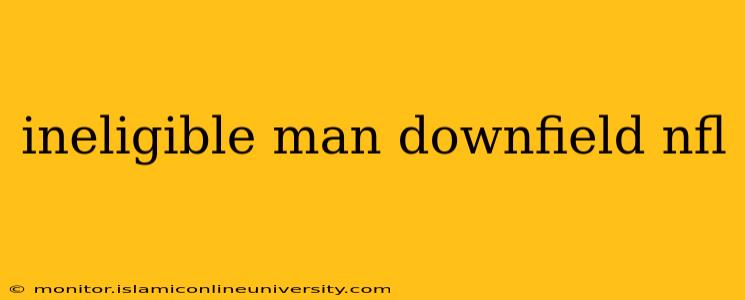The NFL rule regarding ineligible man downfield is a frequent source of confusion for both players and fans alike. Understanding this rule is crucial for appreciating the nuances of the game and for correctly interpreting penalties. This guide will break down everything you need to know about ineligible man downfield, answering common questions and clarifying potential ambiguities.
What is an Ineligible Man Downfield?
An ineligible man downfield is a player who is not allowed to advance downfield past the line of scrimmage beyond a certain point when a forward pass is thrown. Specifically, it's typically offensive linemen (center, guards, tackles) who are ineligible. However, other players can be ineligible in certain situations. The key is their position relative to the line of scrimmage at the snap.
Who is Ineligible?
Generally, offensive linemen (those wearing numbers 50-79) are considered ineligible receivers. They are not allowed to advance downfield beyond the line of scrimmage until the ball is thrown. This is because their primary role is blocking, not receiving. However, the specific eligibility of players depends on their position when the ball is snapped.
Frequently Asked Questions about Ineligible Man Downfield
The following questions frequently appear in searches related to ineligible man downfield penalties:
H2: What happens if an ineligible player catches the ball?
If an ineligible receiver catches a forward pass, the result is an automatic penalty. The offense is penalized 5 yards for an ineligible man downfield. The down is replayed. The play is dead immediately upon the catch. The pass is not considered complete.
H2: What if an ineligible player is downfield but doesn't touch the ball?
Even if the ineligible player doesn't touch the ball, if they are downfield beyond the line of scrimmage when the pass is thrown, a penalty can still be called. The referee has discretion in determining whether the player interfered with the play, even without touching the ball. The presence of an ineligible receiver downfield can create a hindrance that affects the defense's ability to react.
H2: Does it matter if the ineligible player is blocking?
It doesn't matter if the ineligible player is actively blocking. The key is their position relative to the line of scrimmage at the moment the ball is thrown. Being downfield past the line of scrimmage, even while blocking, constitutes a penalty.
H2: When does the ineligible player become eligible?
An ineligible player becomes eligible after the ball is thrown. They are free to move anywhere on the field after the ball leaves the quarterback's hand. The penalty applies only to their position at the snap and the moment the forward pass is released.
H2: Can an ineligible receiver legally block?
Ineligible receivers can legally block after the ball is thrown. The penalty is specifically for being downfield before the pass. Any blocking that happens after the pass is legal provided it doesn't violate other rules of the game (e.g., holding, illegal use of hands).
H2: How is the penalty enforced?
The penalty is a 5-yard loss from the spot of the foul. The down is repeated. This can be very impactful, especially in short-yardage situations or near the goal line.
Conclusion:
The ineligible man downfield rule is designed to maintain fairness and prevent offensive teams from gaining an unfair advantage by having extra eligible receivers downfield. Understanding this rule is vital for fully appreciating the intricacies of NFL football. While the core principle is straightforward, the application can sometimes be nuanced, depending on player positioning and referee interpretation.
